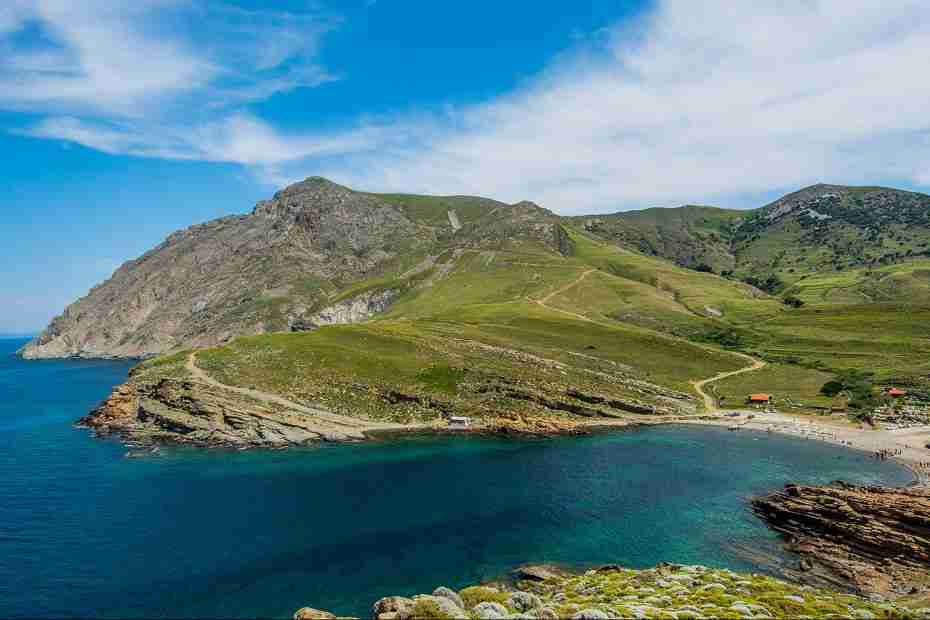Imbros, also known as Gökçeada, sits at the northern edge of the Aegean Sea, marking the entrance to Saros Bay, or the Gulf of Saros. With a 91-kilometer coastline, it boasts İncirburnu, Turkey’s westernmost point. As part of Çanakkale province, Imbros is a popular destination for both local and international tourists. Flights from Istanbul operate twice weekly, and sea transportation is also available.
The island’s stunning landscape showcases a spectrum of colors, from deep reds and greens to light turquoise and dark blue, welcoming visitors with its natural beauty.
Here’s a guide to exploring Turkey’s largest island:

Kaleköy
Kaleköy, one of Imbros’s oldest villages, offers two distinct areas: Aşağı (Down) Kaleköy and Yukarı (Up) Kaleköy. Aşağı Kaleköy boasts lively summer nights with its waterfront, tea gardens, restaurants, and bars. Yukarı Kaleköy is home to İskiter Fortress, a historic site built by the Genoese, offering panoramic views of the surrounding area.
Yıldızkoy (Yıldız Bay)
Yıldızkoy stands out for its unique rock formations and has been designated as an Underwater National Park due to its stunning marine life.
Yenibademli Village
A hub for agriculture and fishing, Yenibademli Village is known for its hospitality, offering hostels and guesthouses for visitors.
Eskibademli Village
Eskibademli Village’s traditional architecture, century-old sycamore tree, and picturesque sunset views make it a must-visit spot.
District Center
Imbros’s district center comprises several historic neighborhoods, including Çınarlı, Cumhuriyet, Fatih, and Kuzulimanı, housing important landmarks like Merkez Mosque and Fatih Mosque.
Zeytinli Village
Set among olive groves, Zeytinli Village offers a glimpse into the island’s Greek heritage and serves renowned Dibek coffee.
Tepeköy
Tepeköy, known for its vibrant Virgin Mary celebrations, offers scenic picnic spots and cool retreats from the summer heat.
Karayolları Çeşmesi (Highway Fountain)
This roadside picnic area boasts serene surroundings, perfect for family outings under the shade of sycamore trees.
Şahinkaya
A village known for its Greek population, Şahinkaya offers a tranquil setting for farming, beekeeping, and dairy production.
Dereköy (İskinit)
Dereköy, once a bustling village, now features abandoned buildings and a historic laundry house worth exploring.
Uğurlu Village
Uğurlu Village, home to migrants from Muğla and Burdur, offers a peaceful retreat with access to Gizli Liman, a pristine beach.
Şirinköy and Laz Bay
Şirinköy, settled by Bulgarian immigrants, offers cozy accommodations amidst agricultural landscapes, while nearby Laz Bay provides a scenic beach getaway.
Eşelek Village and Aydıncık Beach
Eşelek Village, near Bakacak Dam, is known for its agricultural products and burgeoning hostel scene. Aydıncık Beach, with its proximity to Salt Lake, offers camping and windsurfing opportunities.
Salt Lake and Rock-cut Tomb
Salt Lake, rich in mineral mud, is a haven for migratory birds and visitors seeking natural therapy. Nearby, the Rock-cut Tomb provides a glimpse into ancient history.
Kuzu Port and Kaşkaval Cape
Kuzu Port serves as the island’s main gateway, offering a picturesque beach and beach volleyball. Kaşkaval Cape, with its unique rock formations, is best admired from the sea, steeped in local legend.
Imbros is a treasure trove of natural wonders, cultural heritage, and warm hospitality, inviting travelers to explore its diverse landscapes and rich history.
source:
https://www.dailysabah.com/travel/2018/09/01/imbros-turkeys-laid-back-island
